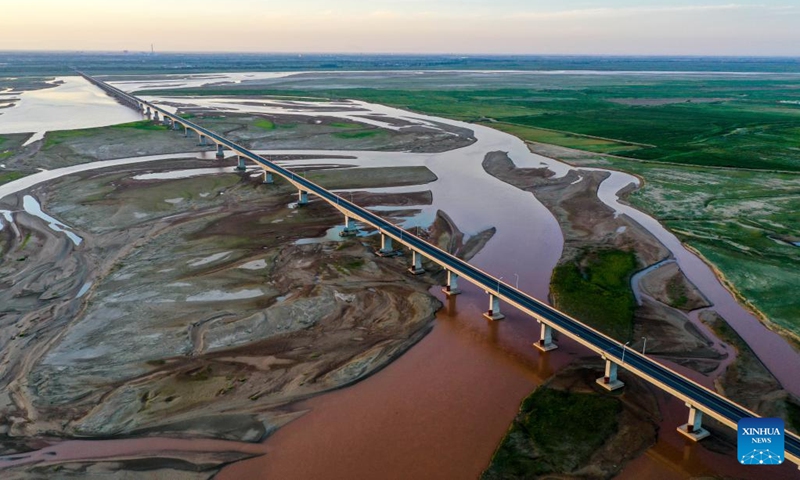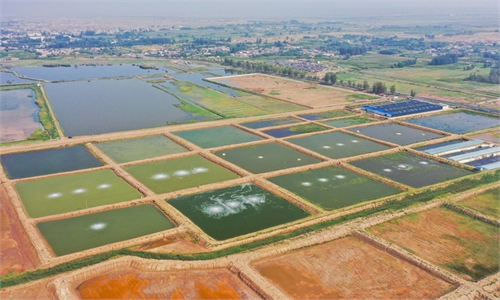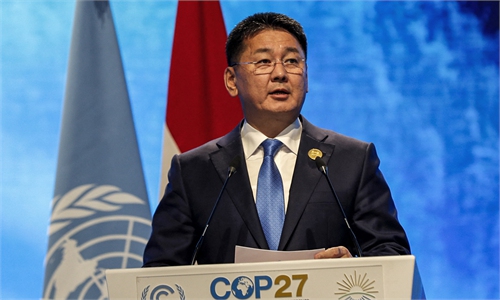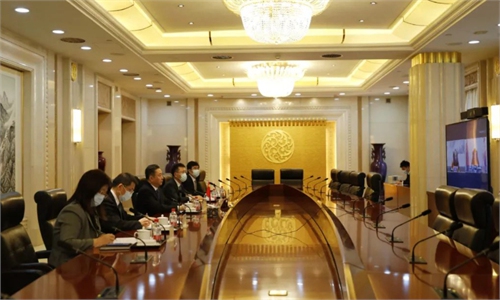
Aerial photo taken on Aug. 16, 2022 shows the Yellow River in Hanggin Banner in Erdos, north China's Inner Mongolia Autonomous Region.(Photo: Xinhua)
Frequent talks between China and Mongolia are being held ahead of a scheduled state visit to China by Mongolian President Ukhnaagiin Khurelsukh from Sunday to Monday, and market watchers predict that the two countries will see closer economic and trade cooperation in many areas such as resources, agriculture, infrastructure and regional connectivity.
China's Minister of Transport Li Xiaopeng and his Mongolian counterpart held a video meeting on Wednesday, during which the two sides discussed plans to enhance cooperation in highways, railways and civil aviation.
"It is hoped that the transport authorities will further enhance the transport connectivity between China and Mongolia, ensure the security, stability and smooth flow of the logistics supply chain, and promote bilateral transport cooperation to a new level, so as to better serve the economic and social development of the two countries and benefit their peoples," said Li.
On the same day, He Zhenwei, president of the China Overseas Development Association (CODA), was invited to attend a conference dinner with Tuvshin Badral, Mongolian Ambassador to China, during which both sides stressed the importance of investment and trade cooperation between China and Mongolia.
On November 14, the China Council for the Promotion of International Trade and the Mongolian National Chamber of Commerce and Industry held a trade matchmaking conference, stressing the need to make good use of the economic complementarity between the two nations and promote win-win cooperation.
"It is expected that the two countries will see closer economic and trade cooperation," Li Xin, director of the Institute for Eurasian Studies at the Shanghai University of Political Science and Law, told the Global Times on Thursday.
For starters, mineral resources trade may see a boost, Li said, adding that there is huge potential for Mongolia to increase agricultural product exports to China as well.
China purchased 780,000 tons of steam coal from Mongolia in October, surging 830 percent year-on-year, per data tracked by Shanxi Securities Co.
A new rail route was put into operation in September linking a coal field in Mongolia to the Gashuunsukhait port bordering China. The 233-kilometer railway could deliver 30-50 million tons of coal to China annually, according to media reports.
In addition, China and Mongolia have great potential to cooperate on infrastructure and regional connectivity. By connecting the Belt and Road Initiative with Mongolia's Prairie Road development strategy, an economic plan that aims to boost trade with neighboring markets, Mongolia could better integrate into the regional economic development framework, experts noted.
The first China-Europe freight train from Jinzhou Port in Northeast China's Liaoning Province to Helsinki, Finland, via Mount Joba in Mongolia, was launched in August 2022, which is in line with the construction of the China-Mongolia-Russia Economic Corridor.
During a China-Russia-Mongolia summit in September, the three countries confirmed the extension of the Outline of the Development Plan on Establishing the China-Mongolia-Russia Economic Corridor by five years. They also officially launched the feasibility study on the upgrading and development of the central-route railway of the China-Mongolia-Russia Economic Corridor, and agreed to actively move forward the project on the Mongolian section of the China-Russia natural gas pipeline.
China has been Mongolia's largest source of investment and trading partner for 18 years in a row, and trade between the two neighboring countries accounts for more than 60 percent of Mongolia's total foreign trade, according to data from the Chinese Academy of Social Sciences' branch in North China's Inner Mongolia.
Customs data showed that bilateral trade hit $9.68 billion in the first 10 months of this year.
Global Times



